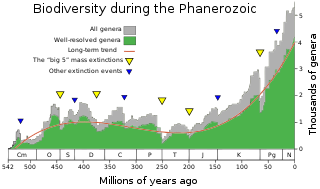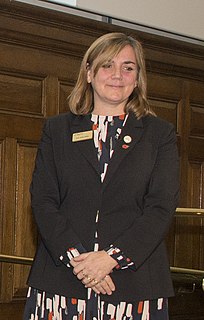Related Research Articles

An extinction event is a widespread and rapid decrease in the biodiversity on Earth. Such an event is identified by a sharp change in the diversity and abundance of multicellular organisms. It occurs when the rate of extinction increases with respect to the rate of speciation. The number of major mass extinctions in the last 440 million years are estimated from as few as five to more than twenty. These differences stem from disagreement as to what constitutes an extinction event as "major", and the data chosen to measure past diversity.

The Holocene extinction, otherwise referred to as the sixth mass extinction or Anthropocene extinction, is an ongoing extinction event of species during the present Holocene epoch as a result of human activity. The included extinctions span numerous families of bacteria, fungi, plants and animals, including mammals, birds, reptiles, amphibians, fish and invertebrates. With widespread degradation of highly biodiverse habitats such as coral reefs and rainforests, as well as other areas, the vast majority of these extinctions are thought to be undocumented, as the species are undiscovered at the time of their extinction, or no one has yet discovered their extinction. The current rate of extinction of species is estimated at 100 to 1,000 times higher than natural background extinction rates.

Macroevolution in the modern sense is evolution that is guided by selection among interspecific variation, as opposed to selection among intraspecific variation in microevolution. This modern definition differs from the original concept, which referred macroevolution to the evolution of taxa above the species level.
The Permian is a geologic period and stratigraphic system which spans 47 million years from the end of the Carboniferous Period 298.9 million years ago (Mya), to the beginning of the Triassic Period 251.902 Mya. It is the last period of the Paleozoic Era; the following Triassic Period belongs to the Mesozoic Era. The concept of the Permian was introduced in 1841 by geologist Sir Roderick Murchison, who named it after the region of Perm in Russia.

Biodiversity is the biological variety and variability of life on Earth. Biodiversity is a measure of variation at the genetic, species, and ecosystem level. Terrestrial biodiversity is usually greater near the equator, which is the result of the warm climate and high primary productivity. Biodiversity is not distributed evenly on Earth, and is richer in the tropics. These tropical forest ecosystems cover less than ten percent of earth's surface, and contain about ninety percent of the world's species. Marine biodiversity is usually higher along coasts in the Western Pacific, where sea surface temperature is highest, and in the mid-latitudinal band in all oceans. There are latitudinal gradients in species diversity. Biodiversity generally tends to cluster in hotspots, and has been increasing through time, but will be likely to slow in the future as a primary result of deforestation. It encompasses the evolutionary, ecological, and cultural processes that sustain life.

Extinction is the termination of a kind of organism or of a group of kinds (taxon), usually a species. The moment of extinction is generally considered to be the death of the last individual of the species, although the capacity to breed and recover may have been lost before this point. Because a species' potential range may be very large, determining this moment is difficult, and is usually done retrospectively. This difficulty leads to phenomena such as Lazarus taxa, where a species presumed extinct abruptly "reappears" after a period of apparent absence.
Biogeography is the study of the distribution of species and ecosystems in geographic space and through geological time. Organisms and biological communities often vary in a regular fashion along geographic gradients of latitude, elevation, isolation and habitat area. Phytogeography is the branch of biogeography that studies the distribution of plants. Zoogeography is the branch that studies distribution of animals. Mycogeography is the branch that studies distribution of fungi, such as mushrooms.

Human ecology is an interdisciplinary and transdisciplinary study of the relationship between humans and their natural, social, and built environments. The philosophy and study of human ecology has a diffuse history with advancements in ecology, geography, sociology, psychology, anthropology, zoology, epidemiology, public health, and home economics, among others.

Conservation biology is the study of the conservation of nature and of Earth's biodiversity with the aim of protecting species, their habitats, and ecosystems from excessive rates of extinction and the erosion of biotic interactions. It is an interdisciplinary subject drawing on natural and social sciences, and the practice of natural resource management.

Coextinction and cothreatened refer to the phenomena of the loss or decline of a host species resulting in the loss or endangerment of an other species that depends on it, potentially leading to cascading effects across trophic levels. The term originated by the authors Stork and Lyal (1993) and was originally used to explain the extinction of parasitic insects following the loss of their specific hosts. The term is now used to describe the loss of any interacting species, including competition with their counterpart, and specialist herbivores with their food source. Coextinction is especially common when a keystone species goes extinct.
Niles Eldredge is an American biologist and paleontologist, who, along with Stephen Jay Gould, proposed the theory of punctuated equilibrium in 1972.

The Early Triassic is the first of three epochs of the Triassic Period of the geologic timescale. It spans the time between 251.902 Ma and 247.2 Ma. Rocks from this epoch are collectively known as the Lower Triassic series, which is a unit in chronostratigraphy.

Species richness, or biodiversity, increases from the poles to the tropics for a wide variety of terrestrial and marine organisms, often referred to as the latitudinal diversity gradient (LDG). The LDG is one of the most widely recognized patterns in ecology. The LDG has been observed to varying degrees in Earth's past. A parallel trend has been found with elevation, though this is less well-studied.

The extinction risk of climate change is the risk of species becoming extinct due to the effects of climate change. Climate change is the long-term conversion of temperature and average weather patterns. Currently, 19% of species on the IUCN Red List of Threatened Species are already being impacted by climate change. Many studies have been conducted on how the effect of climate change can effect global temperatures and environment. Studies done by the Intergovernmental Panel on Climate Change (IPCC) show that it is estimated that the temperature will rise from about 1.4 to 5.5 degrees Celsius within the next century. These rising rates, to a certain degree, may benefit some regions while harming others. However, after about 5.4 degrees Fahrenheit of rising temperature, it will get into harmful climate change. Efforts have been made such as the Paris Climate Agreement, in attempt to stop or reduce the effects of a rising temperature, or at least decrease the number in which the temperature rises.
Anne Elizabeth Magurran is a British Professor of ecology at University of St Andrews in Scotland. She is the author of several books on measuring biological diversity, and the importance for quantifying biodiversity for conservation. She has won numerous awards and honors, is regularly consulted for global assessments and analyses of biodiversity and conservation and her research is often highlighted by journalists.
John Alroy is a paleobiologist born in New York in 1966 and now residing in Sydney, Australia.

Stephen C. Stearns is an American biologist, and the Edward P. Bass Professor of Ecology and Evolutionary Biology Emeritus at Yale University. He is known for his work in life history theory and evolutionary medicine.

The Mesozoic–Cenozoic Radiation is the third major extended increase of biodiversity in the Phanerozoic, after the Cambrian Explosion and the Great Ordovician Biodiversification Event, which appeared to exceeded the equilibrium reached after the Ordovician radiation. Made known by its identification in marine invertebrates, this evolutionary radiation began in the Mesozoic, after the Permian extinctions, and continues to this date. This spectacular radiation affected both terrestrial and marine flora and fauna, during which the “modern” fauna came to replace much of the Paleozoic fauna. Notably, this radiation event was marked by the rise of angiosperms during the mid-Cretaceous, and the K-Pg extinction, which initiated the rapid increase in mammalian biodiversity.

Katherine Jane Willis is a biologist, who studies the relationship between long-term ecosystem dynamics and environmental change. She is Professor of Biodiversity in the Department of Zoology, University of Oxford, and an adjunct Professor in Biology at the University of Bergen. In 2018 she was elected as Principal of St Edmund Hall, and took up this position from 1 October. She held the Tasso Leventis Chair of Biodiversity at Oxford and was founding Director, now Associate Director, of the Biodiversity Institute Oxford. Willis was Director of Science at the Royal Botanic Gardens, Kew from 2013-2018.

Mark C. Urban is a biologist and associate professor in ecology and evolutionary biology at the University of Connecticut. His work focuses on the ecological and evolutionary mechanisms that shape natural communities across multiple spatial scales.
References
- 1 2 Mayhew, Peter J (2006). Discovering Evolutionary Ecology. Oxford: Oxford University Press. ISBN 978-0-19-857060-8. OCLC: 62133413 .
- ↑ Mayhew, P. J.; Jenkins, G. B.; Benton, T. M. (7 January 2008). "A long term association between global temperature and biodiversity, origination and extinction in the fossil record". Proceedings of the Royal Society B. London: Royal Society. 275 (1630): 47–53. doi:10.1098/rspb.2007.1302. PMC 2562410 . PMID 17956842.
- ↑ Borenstein, Seth (24 October 2007). "Warmer seas spark extinction worries". Toronto Star. Retrieved 1 January 2008.
- ↑ "Great Britons". Archived from the original on 2 November 2007. Retrieved 1 January 2007.